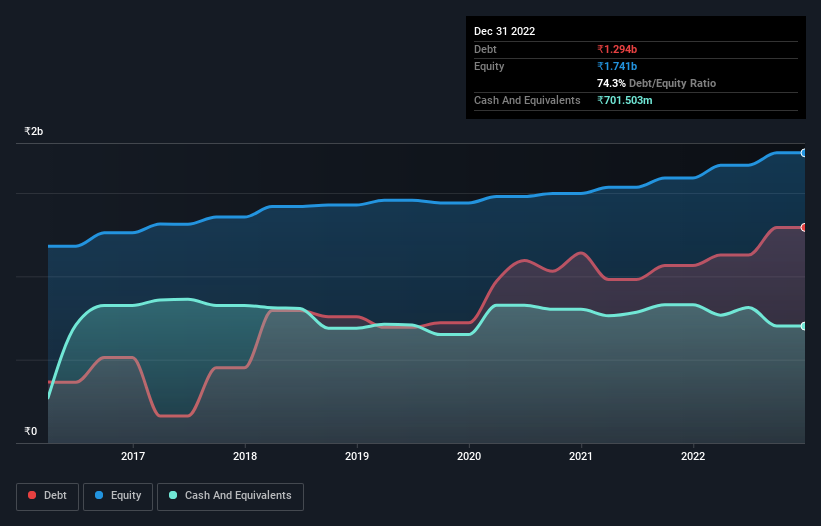We Think IntraSoft Technologies (NSE:ISFT) Is Taking Some Risk With Its Debt
The external fund manager backed by Berkshire Hathaway's Charlie Munger, Li Lu, makes no bones about it when he says 'The biggest investment risk is not the volatility of prices, but whether you will suffer a permanent loss of capital.' So it seems the smart money knows that debt - which is usually involved in bankruptcies - is a very important factor, when you assess how risky a company is. We note that IntraSoft Technologies Limited (NSE:ISFT) does have debt on its balance sheet. But is this debt a concern to shareholders?
What Risk Does Debt Bring?
Generally speaking, debt only becomes a real problem when a company can't easily pay it off, either by raising capital or with its own cash flow. In the worst case scenario, a company can go bankrupt if it cannot pay its creditors. However, a more common (but still painful) scenario is that it has to raise new equity capital at a low price, thus permanently diluting shareholders. Of course, debt can be an important tool in businesses, particularly capital heavy businesses. When we think about a company's use of debt, we first look at cash and debt together.
View our latest analysis for IntraSoft Technologies
How Much Debt Does IntraSoft Technologies Carry?
As you can see below, at the end of September 2022, IntraSoft Technologies had ₹1.29b of debt, up from ₹1.06b a year ago. Click the image for more detail. However, it also had ₹701.5m in cash, and so its net debt is ₹592.2m.

How Strong Is IntraSoft Technologies' Balance Sheet?
We can see from the most recent balance sheet that IntraSoft Technologies had liabilities of ₹358.0m falling due within a year, and liabilities of ₹1.36b due beyond that. Offsetting these obligations, it had cash of ₹701.5m as well as receivables valued at ₹36.9m due within 12 months. So its liabilities total ₹983.9m more than the combination of its cash and short-term receivables.
This is a mountain of leverage relative to its market capitalization of ₹1.58b. Should its lenders demand that it shore up the balance sheet, shareholders would likely face severe dilution.
In order to size up a company's debt relative to its earnings, we calculate its net debt divided by its earnings before interest, tax, depreciation, and amortization (EBITDA) and its earnings before interest and tax (EBIT) divided by its interest expense (its interest cover). The advantage of this approach is that we take into account both the absolute quantum of debt (with net debt to EBITDA) and the actual interest expenses associated with that debt (with its interest cover ratio).
IntraSoft Technologies has a debt to EBITDA ratio of 4.1 and its EBIT covered its interest expense 4.8 times. Taken together this implies that, while we wouldn't want to see debt levels rise, we think it can handle its current leverage. We saw IntraSoft Technologies grow its EBIT by 5.8% in the last twelve months. Whilst that hardly knocks our socks off it is a positive when it comes to debt. There's no doubt that we learn most about debt from the balance sheet. But it is IntraSoft Technologies's earnings that will influence how the balance sheet holds up in the future. So if you're keen to discover more about its earnings, it might be worth checking out this graph of its long term earnings trend.
Finally, a business needs free cash flow to pay off debt; accounting profits just don't cut it. So we always check how much of that EBIT is translated into free cash flow. Over the last three years, IntraSoft Technologies saw substantial negative free cash flow, in total. While that may be a result of expenditure for growth, it does make the debt far more risky.
Our View
Mulling over IntraSoft Technologies's attempt at converting EBIT to free cash flow, we're certainly not enthusiastic. But at least its EBIT growth rate is not so bad. Overall, we think it's fair to say that IntraSoft Technologies has enough debt that there are some real risks around the balance sheet. If all goes well, that should boost returns, but on the flip side, the risk of permanent capital loss is elevated by the debt. The balance sheet is clearly the area to focus on when you are analysing debt. However, not all investment risk resides within the balance sheet - far from it. For instance, we've identified 4 warning signs for IntraSoft Technologies that you should be aware of.
If you're interested in investing in businesses that can grow profits without the burden of debt, then check out this free list of growing businesses that have net cash on the balance sheet.
New: AI Stock Screener & Alerts
Our new AI Stock Screener scans the market every day to uncover opportunities.
• Dividend Powerhouses (3%+ Yield)
• Undervalued Small Caps with Insider Buying
• High growth Tech and AI Companies
Or build your own from over 50 metrics.
Have feedback on this article? Concerned about the content? Get in touch with us directly. Alternatively, email editorial-team (at) simplywallst.com.
This article by Simply Wall St is general in nature. We provide commentary based on historical data and analyst forecasts only using an unbiased methodology and our articles are not intended to be financial advice. It does not constitute a recommendation to buy or sell any stock, and does not take account of your objectives, or your financial situation. We aim to bring you long-term focused analysis driven by fundamental data. Note that our analysis may not factor in the latest price-sensitive company announcements or qualitative material. Simply Wall St has no position in any stocks mentioned.
About NSEI:ISFT
IntraSoft Technologies
Through its subsidiaries, engages in the development and delivery of e-commerce and e-cards through internet platform in India and internationally.
Excellent balance sheet and slightly overvalued.
Market Insights
Community Narratives




